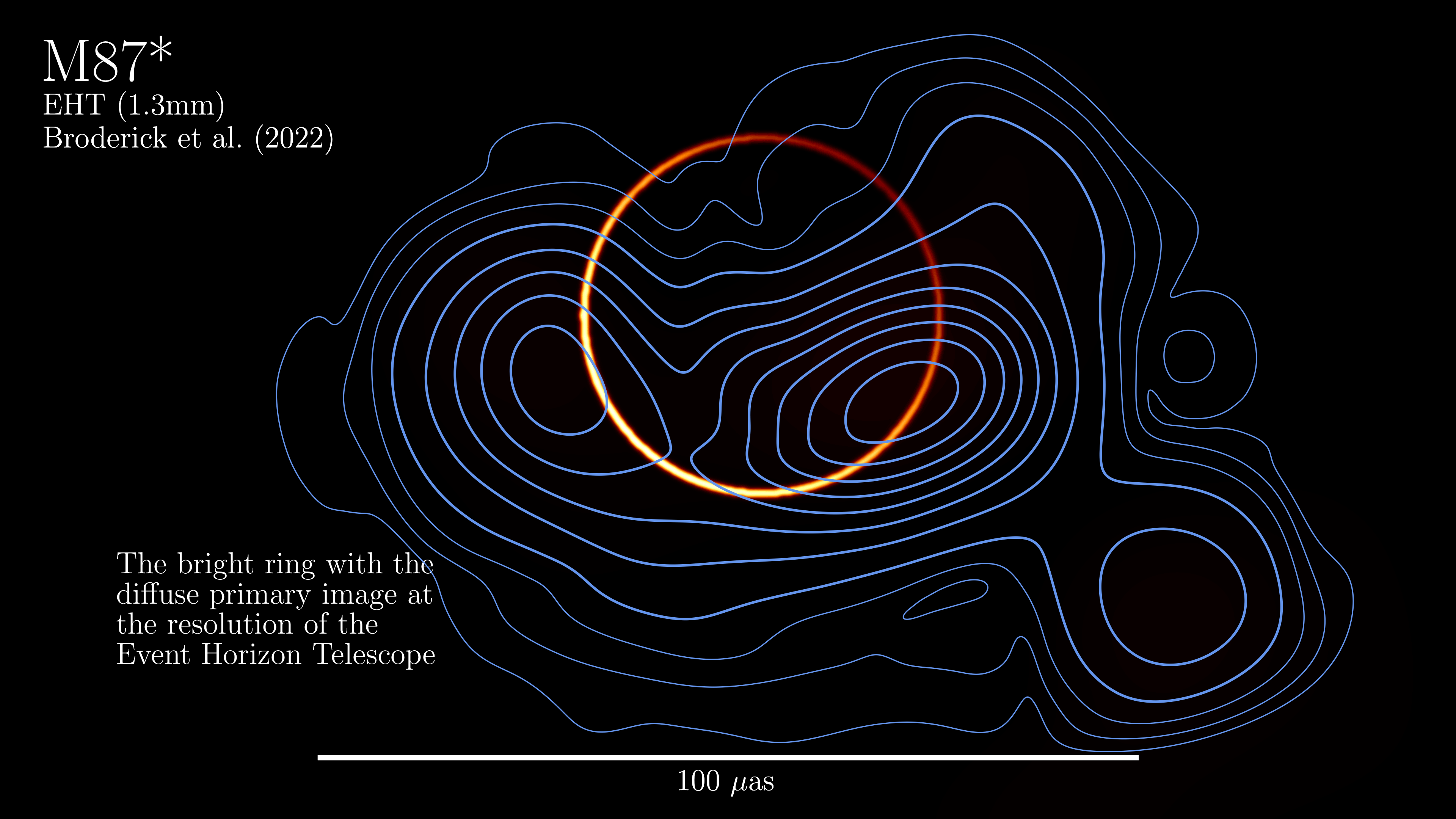M87의 방출은 이제 방출 영역의 무한한 추가 이미지 시퀀스에서 비롯된 얇고 밝은 고리(주황색)와 지구를 향해 직접 오는 광자에 의해 생성된 더 확산된 원시 이미지(파란색 특징)로 분해되었습니다. . Event Horizon Telescope의 이미징 해상도를 보면 두 구성 요소가 함께 희미해집니다. 그러나 얇은 고리를 별도로 검색하면 M87의 강한 중력 각인을 분리하여 시야를 선명하게 할 수 있습니다. 크레딧: Broderick et al. 2022, ABJ, 935, 61
이론적인 예측의 생생한 확인으로 과학자들은 초질량 블록의 뒷면을 감싸는 광자에 의해 야기된 날카로운 빛의 고리를 감지했습니다.[{” attribute=””>black hole.
When astronomers revealed humanity’s historic first image of a black hole in 2019 – depicting a dark core encircled by a fiery aura of material falling toward it – they believed even richer imagery and insights were waiting to be extracted from the data.
Simulations predicted that there should be a thin, bright ring of light, hidden behind the glare of the diffuse orange glow, created by photons flung around the back of the black hole by its intense gravity.
Astrophysicist Avery Broderick led a team of researchers who used sophisticated imaging algorithms to essentially “remaster” the original imagery of the supermassive black hole at the center of the M87 galaxy.
“We turned off the searchlight to see the fireflies,” said Broderick, an associate faculty member at Perimeter Institute and the University of Waterloo. “We have been able to do something profound – to resolve a fundamental signature of gravity around a black hole.”
By essentially “peeling off” elements of the imagery, says co-author Hung-Yi Pu, an assistant professor at National Taiwan Normal University, “the environment around the black hole can then be clearly revealed.”
To accomplish this, the team of researchers used a new imaging algorithm within the Event Horizon Telescope (EHT) analysis framework THEMIS to isolate and extract the distinct ring feature from the original observations of the M87 black hole. They were also able to detect the telltale footprint of a powerful jet blasting outward from the black hole.
The scientists’ findings both confirm theoretical predictions and offer new ways to explore these mysterious objects, which are thought to reside at the heart of most galaxies.
Black holes were long considered unseeable until scientists coaxed them out of hiding with the EHT, a globe-spanning network of telescopes. Using eight observatories on four continents, all pointed at the same spot in the sky and linked together with nanosecond timing; the EHT researchers observed two black holes in 2017.
The EHT collaboration first unveiled the supermassive black hole in M87 in 2019. Then in 2022, it revealed the comparatively small but tumultuous black hole at the heart of our own Milky Way galaxy, called Sagittarius A* (or Sgr A*). Supermassive black holes occupy the center of most galaxies, packing an extraordinary amount of mass and energy into a small space. The M87 black hole, for example, is two quadrillion (that’s a two followed by 15 zeros) times more massive than Earth.
Although the M87 image scientists unveiled in 2019 was a landmark, the scientists thought they could sharpen the image and glean new insights by working smarter, not harder. They applied new software techniques to reconstruct the original 2017 data in search of phenomena that theories and models predicted were lurking beneath the surface. The new, resulting image depicts the photon ring, comprised of a series of increasingly sharp sub-rings, which the team then stacked to get the full image.
“The approach we took involved leveraging our theoretical understanding of how these black holes look to build a customized model for the EHT data,” said Dominic Pesce, a team member based at the Center for Astrophysics | Harvard & Smithsonian. “This model decomposes the reconstructed image into the two pieces that we care most about, so we can study both pieces individually rather than blended together.”
The result was possible because the EHT is a “computational instrument at its heart,” said Broderick, who holds the Delaney Family John Archibald Wheeler Chair at Perimeter. “It is as dependent on algorithms as it is upon steel. Cutting-edge algorithmic developments have allowed us to probe key features of the image while rendering the remainder in the EHT’s native resolution.”
Reference: “The Photon Ring in M87*” by Avery E. Broderick, Dominic W. Pesce, Roman Gold, Paul Tiede, Hung-Yi Pu, Richard Anantua, Silke Britzen, Chiara Ceccobello, Koushik Chatterjee, Yongjun Chen, Nicholas S. Conroy, Geoffrey B. Crew, Alejandro Cruz-Osorio, Yuzhu Cui, Sheperd S. Doeleman, Razieh Emami, Joseph Farah, Christian M. Fromm, Peter Galison, Boris Georgiev, Luis C. Ho, David J. James, Britton Jeter, Alejandra Jimenez-Rosales, Jun Yi Koay, Carsten Kramer, Thomas P. Krichbaum, Sang-Sung Lee, Michael Lindqvist, Iván Martí-Vidal, Karl M. Menten, Yosuke Mizuno, James M. Moran, Monika Moscibrodzka, Antonios Nathanail, Joey Neilsen, Chunchong Ni, Jongho Park, Vincent Piétu, Luciano Rezzolla, Angelo Ricarte, Bart Ripperda, Lijing Shao, Fumie Tazaki, Kenji Toma, Pablo Torne, Jonathan Weintroub, Maciek Wielgus, Feng Yuan, Shan-Shan Zhao and Shuo Zhang, 16 August 2022, The Astrophysical Journal.
DOI: 10.3847/1538-4357/ac7c1d

“경순은 통찰력 있고 사악한 사상가로, 다양한 음악 장르에 깊은 지식을 가지고 있습니다. 힙스터 문화와 자연스럽게 어우러지는 그의 스타일은 독특합니다. 그는 베이컨을 좋아하며, 인터넷 세계에서도 활발한 활동을 보여줍니다. 그의 내성적인 성격은 그의 글에서도 잘 드러납니다.”
